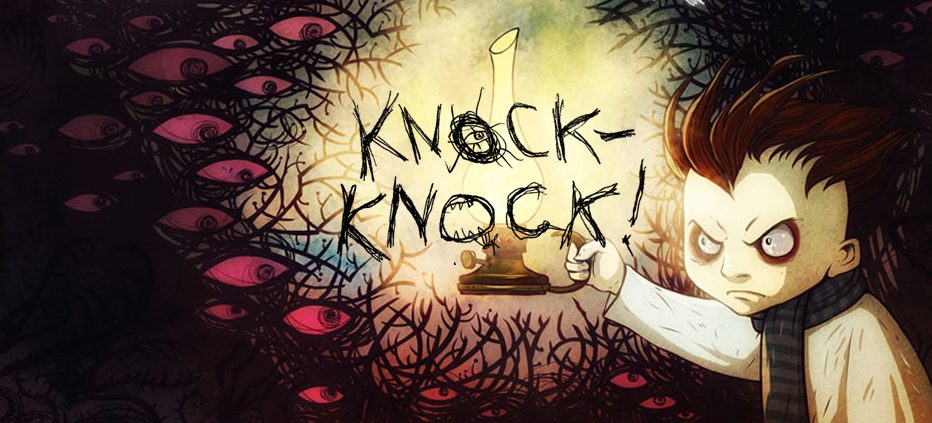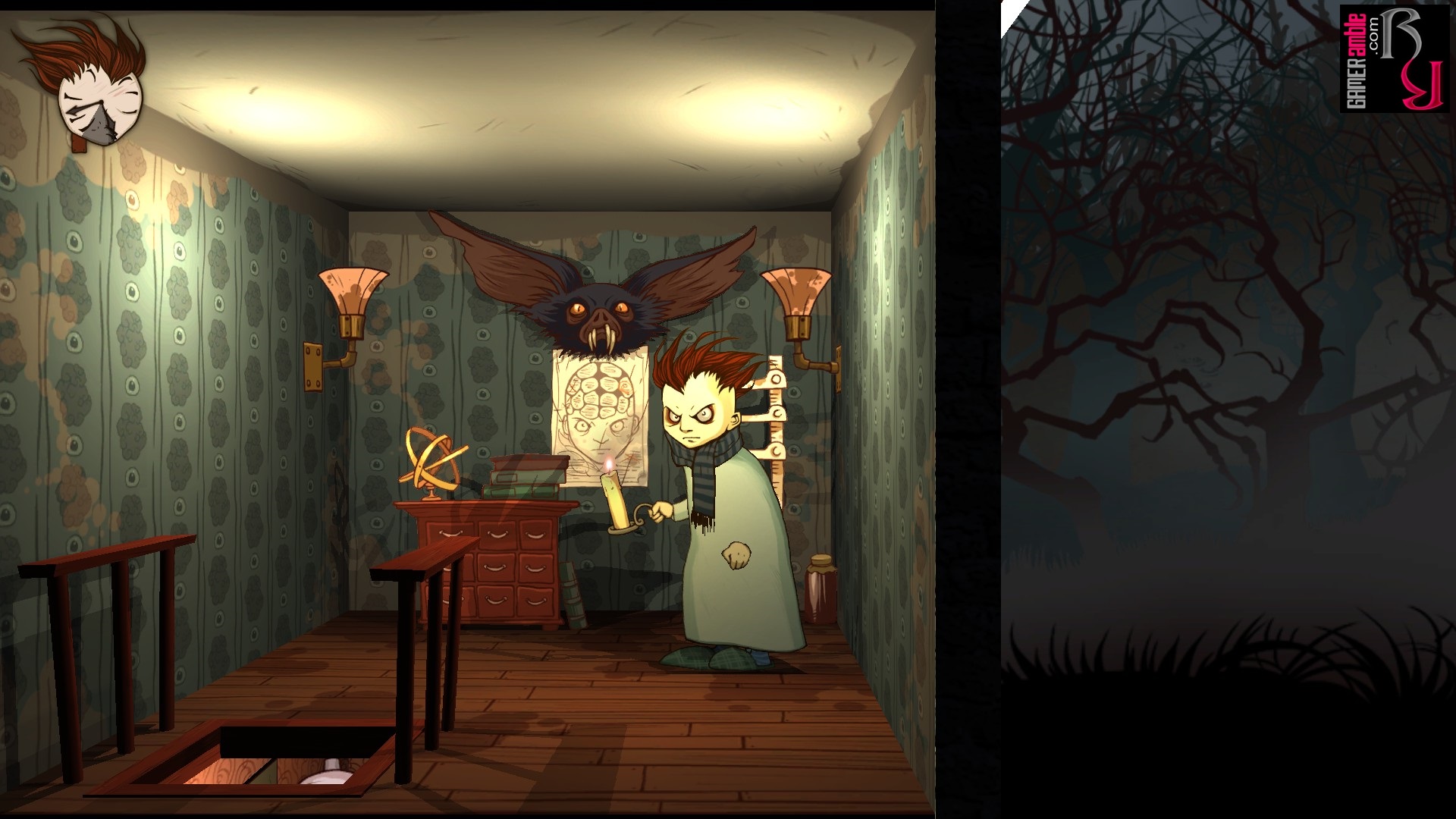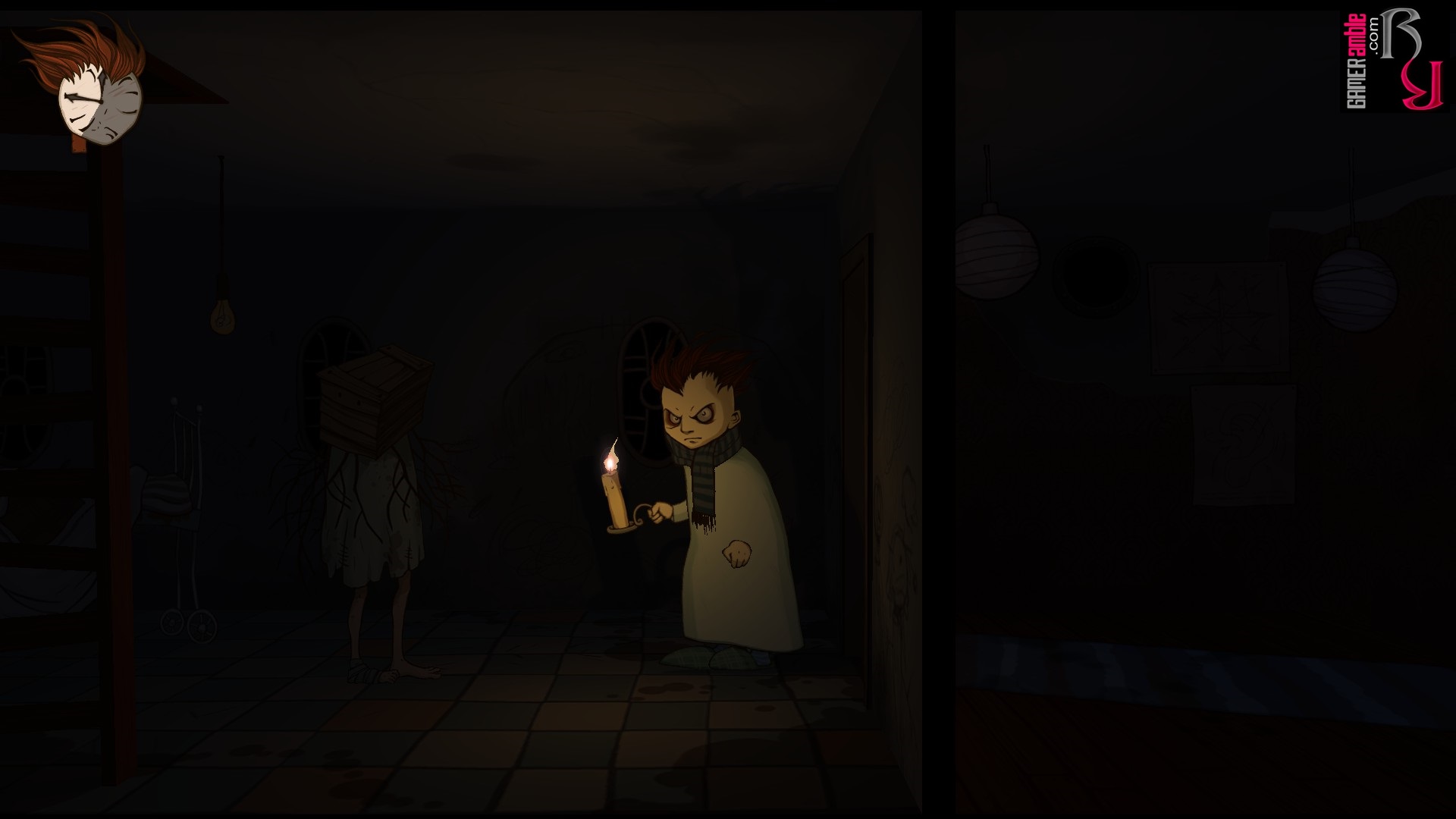Knock-knock
Developer: Ice-Pick Lodge | Publisher: Ice-Pick Lodge | Release Date: 2013 | Genre: Horror / Indie | Website: Official Website | Purchase: Steam
Count yourself very lucky if you have never woken up in the middle of the night after hearing a strange noise from somewhere in your house. It is even worse if you can’t be sure whether the noise that woke you came from your house or was just part of a dream. Knock-Knock is an indie game that captures this feeling of dread and being disoriented perfectly, but depending on how willing you are to figure things out for yourself, it may be too obscure for most players.
The game opens with a cryptic message telling you it is not actually a game but an experience. You then discover that the character you control is a wide-eyed insomniac clad only in pajamas, a scarf, and some slippers. With his unruly hair and the dark circles beneath his eyes, he certainly doesn’t look like someone you would want to encounter in the dark. Apparently, our protagonist is known only as the “Lodger,” and he has a bit of an issue with his house. It is an unusual cabin situated deep within the woods, where he and his predecessors all worked as “world-ologists” whatever that may be. Lately, the Lodger has begun to notice strange things in the house that has served as a lab and dwelling for three generations of Lodgers. Things have started to go missing; his sleep is constantly interrupted by strange noises, and he has a dreadful feeling that something odd is coming out of the woods and infiltrating his house. The question is, are there really supernatural events taking place, or is it all simply in his head?
To say that Knock-Knock is a unique game would be an understatement. It initially appears to be some type of survival horror title, but it does a marvelous job of not really explaining anything to players. In fact, we would wager that most players end up wandering around aimlessly in the house they are tasked with safeguarding without really knowing what to do. You see, there is no way to attack the unwanted “guests” that appear in your house, and the only way to avoid them is by hiding. The game simply tells you to stay awake and sane until dawn, but this seemingly simple task is complicated by a game that flat-out refuses to hold your hand.
The basic gameplay mechanics of Knock-Knock involve walking from room to room in your house with its 2D, randomized rooms. In each room, you can hold down a button to fix the light in the room, which will banish all the shadows and allow you to walk through the room at a brisk pace instead of creeping, which is your default speed in the dark. In most rooms, you’ll notice that the Lodger will close his eyes as soon as you switch on the light, allowing him to “remember” the contents of the room, which then becomes visible. This is vital as most of the rooms in the house are entirely bare until you do this, which means there is no place to hide.
One might think that the best way to stay safe until dawn is to switch on all the lights and hide somewhere, but this is actually the worst thing you can do. For one thing, you cannot see the “guests” at all in rooms where the light is on, so you have no way of noticing them sneaking up on you. Contact with a guest results in your character losing time, which means it will take longer for dawn to arrive. If you lose too much time, it’s back to the start of the level. Hiding also has a downside, as time will flow backward while you do it, which means you’ll never see dawn if you cower away behind something. Finally, the Lodger has lost something very important, and exploring all the rooms in the house is the only way of discovering it again and discovering more about the cryptic story. Of course, the game doesn’t explain any of this to you, which can make things very confusing until you figure it out.
Another thing that makes Knock-Knock extremely tricky is the randomized nature of the game. The house changes each night, and some layouts are just way more hazardous than others. It is also very easy to end up in situations with nowhere to hide and multiple guests heading your way, which is highly frustrating. Luckily, you can zoom out to view the entire house, which helps you plan ahead about where to go next and which rooms to avoid. The games also warn you where the “breaches” that let in the guests will appear, but you must reach them in time to switch on the light and prevent them from opening. Lightning flashes highlight the location of each room that is about to be breached, but sometimes, you are too far away to get to them in time. Then there are the maze-like forest levels where you venture outside your house and try to catch up with a girl hiding some interesting secrets. Your character can even enter the breaches that spawn the guests, but while there are certain advantages for doing so, the outcome is always restarting the level.
If you make it far enough into the game, there is even a sanity meter that comes into play. Once again, this is bound to be the source of frustration for players as the game never explains what it is and just how valuable time becomes once it is active. Let’s just say that it is entirely too easy to end up with no sanity and no option but to restart the entire game if you are not careful. Unlike the clocks you can find throughout the game that enable you to fast-forward time, there is no way to regain lost sanity.
While it is easy to criticize the obscure gameplay elements of Knock-Knock, there is no faulting the visuals. Ice-Pick Lodge has chosen a unique art style for the game, and while it appears very cartoonish at first, it matches the creepy atmosphere perfectly. The Lodger looks positively unhinged, especially when he stares straight at the screen while addressing the player. His hair also has a habit of casting some very disturbing shadows on the walls. The “guests” are also a creepy bunch, ranging from piles of leaves with legs sticking out of them to headless apparitions in straitjackets and even a doppelgänger.
Knock-Knock also excels when it comes to audio, and while it doesn’t have much in the way of music, it more than makes up for it with the sound effects. Playing this game alone in the dark with headphones is an unnerving experience purely because of the constant knocking, creaking, and other sounds that bombard you. You’ll also hear whispers occasionally, and the Lodger has his own gibberish way of talking. A couple of times, we were so engrossed in the game that we jumped as a door slammed in our face, or a light bulb exploded in a shower of sparks.
Overall, we like a lot about Knock-Knock, and we can certainly appreciate how unique it is, but there is no denying that it is a very divisive game. Some players will enjoy playing cat and mouse with the visitors in your house, while others will see nothing except tedium and repetition. The confusing hallway and forest segments don’t do much to endear the game to players, either. The fact that it is so easy to reach the final levels in the game only to find that you don’t have enough sanity to proceed is also pretty harsh. Then, there are the technical difficulties that we encountered. For some reason, the Lodger slowed down nearly to a crawl when creeping in the dark, and initially, we thought this was how the game worked. It wasn’t until we messed around with the vertical sync settings in the NVIDIA control panel that we got him to creep at an average speed. Another peculiar aspect of the game is how you can fix the light bulbs in a room from anywhere you stand, which is rather odd if the light bulb is actually located in the center of the room.
Knock-Knock is not a game to play if you expect easy answers or a game that guides you every step of the way. However, you might appreciate the game if you want to experience a survival horror title where the scares are more psychological than anything else. It definitely requires some patience and perseverance if you’re going to get the most out of it, but in the end it intrigued us enough that we had to see it through all the way to the end. Some flaws may be a little too much for most players to overlook, but if you can look past them, you will find an interesting and unique game.
System Requirements
- Minimum PC System Requirements
- Minimum Mac OS X System Requirements
- Recommended Mac OS X System Requirements
- Minimum SteamOS + Linux System Requirements
- OS: Windows XP or later
- Graphics: GPU that supports shader model 2.0
- Storage: 700 MB available space
- OS: Mac OS X 10.5 or later
- Graphics: Intel HD Graphics 3000
- Storage: 700 MB available space
- Graphics: Intel HD Graphics 4000
- OS: Ubuntu 10.10 or later
- Graphics: GPU that supports shader model 2.0
- Storage: 700 MB available space






















